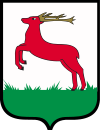Piła
| Piła | |||
|---|---|---|---|
 |
|||
|
|||
| Coordinates: 53°9′N 16°44′E / 53.150°N 16.733°E | |||
| Country |
|
||
| Voivodeship |
|
||
| County | Piła County | ||
| Gmina | Piła (urban gmina) | ||
| Established | 14th century | ||
| Town rights | before 1449 | ||
| Government | |||
| • Mayor | Piotr Głowski | ||
| Area | |||
| • Total | 102.68 km2 (39.64 sq mi) | ||
| Highest elevation | 134 m (440 ft) | ||
| Lowest elevation | 50 m (160 ft) | ||
| Population (2006) | |||
| • Total | 75,044 | ||
| • Density | 730/km2 (1,900/sq mi) | ||
| Time zone | CET (UTC+1) | ||
| • Summer (DST) | CEST (UTC+2) | ||
| Postal code | 64-900, 64-920, 64-931, 64-933 to 64-935, 64-970 | ||
| Area code(s) | +48 067 | ||
| Car plates | PP | ||
| Climate | Dfb | ||
| Website | http://www.pila.pl | ||
Piła [ˈpʲiwa] (German: Schneidemühl) is a town in northwestern Poland. It had 77,000 inhabitants as of 2001. It is situated in the Greater Poland Voivodeship (since 1999), previously capital of Piła Voivodeship (1975–1998). Piła is the largest town in the northern part of Great Poland. It is the capital of Piła County. The town is located on the Gwda river and is famous for its green areas, parks and dense forests nearby. It is an important road and railway hub, located at the intersection of two main lines - Poznań - Szczecin and Bydgoszcz - Krzyż Wielkopolski.
Piła is a Polish word meaning "saw". This was a typical name denoting a village of woodcutters belonging to a local noble. The German name Schneidemühl means "sawmill".
Piła traces its origins to an old fishing village, according to the website of the city Following the German colonist movement of the 13th century, and particularly after the end of the 1241 Mongolian invasions, many German colonizers came to this densely wooded area of the Kingdom of Poland. General immigration of German settlers diminished, however, when Poland, under King Casimir IV Jagiellon (1447–92), finally defeated the Teutonic Order in 1466.
...
Wikipedia



